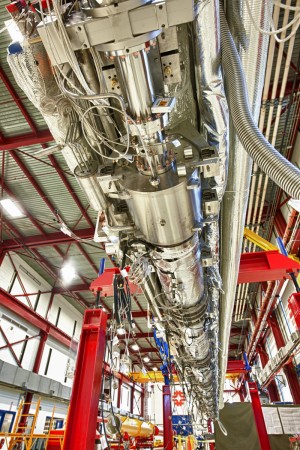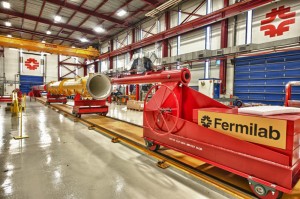Fermilab researchers and technicians are currently busy completing the final assembly of CM2, the first US cryomodule in which every one of its eight superconducting cavities meets ILC specifications.
As such, it is the material realisation of years of beam testing, cavity manufacturing, and niobium processing. It’s also the first significant tangible step in establishing an ILC test facility at Fermilab.
“It’s the first cryomodule at NML with ILC performance and the institutional strength of Fermilab behind it,” said Global Design Effort Project Manager Marc Ross. NML is a recently completed laboratory building that will house the cryomodule.
Meeting the criteria for perhaps the most ambitious specification for ILC’s superconducting radiofrequency (SRF) programme, seven of the eight cavities have a gradient of 35 megavolts per metre; the other is close behind, at 33 MV/m. Once the eight components are strung together inside the cryovessel, scientists hope that the average gradient of its eight-cavity string remains high at 31.5 MV/m.
“SRF field is a tedious and does not forgive even a simple error,” said Tug Arkan, lead engineer responsible for CM2 assembly at Fermilab’s Cryomodule Assembly Facility.
CM2 takes over from its predecessor, CM1, which was assembled in 2007 by Fermilab personnel using a kit from DESY in Germany and was installed and began operation in November 2010. Over the past year it has served as a training ground for lab personnel to learn and test a new cryomodule setup infrastructure. Their experience informs the way they will deal with CM2, which has a few new parts. Where CM1 had a nonfunctioning placeholder, CM2 has a working corrector coil magnet with CERN-designed current leads. And where CM1 used end-style-type tuners, CM2 uses INFN, Italy-designed blade-type tuners.
“Even though there are several components changes for CM2, the assembly and operation of CM1 gave us the opportunity to apply lessons learned from CM1 to the CM2 assembly,” Arkan said.
For one, researchers became better acquainted with a cryomodule’s subtleties in thermometry and cooling. This time around, they’ll position sensors in places that were revealed to be CM1’s blind spots. In assembling the cryomodule, they also paid especially close attention to the cooling straps, ensuring they make good contact so that components don’t overheat.
There was also the matter of perfectly aligning eight metre-long cavities and a focussing magnet, strung end to end, to within 0.1 millimetres – about the thickness of a human hair.
“Even a slight temperature change as someone touches the cavities will throw the alignment process to a halt,” Arkan said. Researchers continually checked the placement of the tripod-supported laser tracker and a reference point on the floor to ensure measurement validity.

Fermilab’s Jim Rife and Jeff Wittenkeller inspect CM2 in Fermilab’s Industrial Center Building. Image: Reidar Hahn
The nature of lessons learned isn’t confined to technological areas. The year spent with CM1 taught Fermilab’s team how to optimise their workflow for processing cavities in the cleanroom and efficient cryomodule assembly.
Such improvements will be made easier by one simple but dramatic difference between CM1 and CM2: all CM2 cavities were processed in the US.
Over the last three years, Jefferson Lab in Newport News, US, under the auspices of the ILC Americas Regional Team and in close collaboration with Fermilab, worked to bring these cavities to ILC-gradient and quality factor through a number of surface processing and cryogenic testing processes at its SRF facilities.
The qualifed cavities then headed west to Fermilab, where they were dressed and tested in the lab’s horizontal test stand and were confirmed to conform to ILC criteria. After initial qualification, researchers performed additional surface processing on the cavities at the joint Fermilab-Argonne cavity processing facility located at Argonne National Laboratory in Argonne, US
“I think a big key is the fact that we have all the cavity test information,” said Fermilab scientist Elvin Harms, who oversees cryomodule commissioning.
As a DESY kit, CM1 didn’t come with all the documentation Fermilab needed to draw out its best performance. “Now we’ll have a better handle on what kind of performance we can expect from CM2. We know it a lot better,” Harms said.
CM2 bears both the ILC and Fermilab stamps in other respects. All of its cavities, which hail from two companies – one in the US, one in Germany – were processed at Fermilab. It will be the first to carry an ILC-like beam going through a cryomodule at NML. Its power feeds and controls were developed according to ILC requirements.
“CM2 is critical for our plans to ultimately provide a facility for accelerator R&D based on the high-energy beam provided by three ILC cryomodules that make up an RF unit,” Fermilab Associate Laboratory Director for Accelerators Stuart Henderson said, referring to the lab’s near-future goal to install a three-cryomodule unit at NML.
The SRF advances represented in CM2 are promising also for the lab’s own future programmes, particularly at the Intensity Frontier. “It’s evidence of the tremendous capability that has been built to master and make use of SRF technology, which bodes well for our ambitions to build Project X,” he said. Project X, a high-intensity proton accelerator complex that will also use SRF cavities.
The CM2 ‘cold mass’ – the 12-metre-long, 4-tonne cryovessel and its cryogenic components – was recently moved from its assembly site to its current location, where the eight SRF cavities will be carefully placed inside it. The very orchestration involved in moving a large and heavy piece of delicate engineering was an event in itself, Arkan said.
“This move is always exciting for all the personnel involved,” Arkan said. “You have to ensure that the gravity loads are minimal during the move, so extra attention was given to this highly engineered transport process.”
CM2 will be moved again in early 2012 to its permanent home as part of the Advanced Superconducting Test Accelerator at NML. By springtime, CM2 should be cooled down to the SRF signature temperature of 2 Kelvin, powered up, and ready to run.



Recent Comments